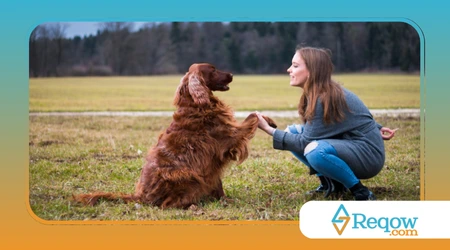Training Deaf Dogs: How to Use Visual and Vibration Signals to Communicate

THE training for deaf dogs It may seem challenging at first, but it is an incredibly rewarding journey.
Advertisements
Learning to communicate with a dog that can't hear opens up a world of new possibilities.
The key lies in adapting our approaches and using the rich visual and vibratory capacity of our four-legged friends.
The World Through Their Eyes: Understanding Canine Perception
Dogs that are deaf, either from birth or due to some acquired condition, compensate for their lack of hearing with heightened visual perception.
They become true masters at reading body language and facial expressions.
Advertisements
Our communication must, therefore, migrate from verbal to gestural.
The absence of ambient sounds also sharpens other senses, such as smell.
This makes them exceptional at tracking and detection, qualities we can use to our advantage in training.
Understanding these inherent abilities is the first step to effective training.
Read more: How to deal with jealousy between pets and children at home
Adapting the home environment is crucial for the safety of a deaf dog.
Small changes can make a big difference, like installing light chimes or vibration-transmitting floors.
Think about how the world presents itself to them.
Visual Signals: The Universal Language of Gestures
Creating a vocabulary of visual signs is the backbone of training for deaf dogs. Start with basic, consistent commands, using clear, exaggerated movements.
Imagine yourself as a conductor conducting an orchestra.
A simple “sit” can turn into a downward hand movement.
The "stay" sign is an open palm facing the dog. Repetition and patience are your best allies in this process.
It's vital that all family members use the same signals. Consistency prevents confusion and speeds up your dog's learning.
Create a "glossary" of signals for reference. Begin training in distraction-free environments.
As your dog becomes familiar with the cues, introduce new locations and situations. Generalizing commands is essential for success.
Use high-value rewards to reinforce desired behavior.
Tasty treats and enthusiastic praise (accompanied by a visual “well done!” signal) are powerful motivators.
Remember that every dog learns at its own pace.
Don't get frustrated if progress is slow. Celebrate each small victory and keep the process fun and positive.
A practical example: to teach the "here" command, you can wave your open hand at waist height, followed by a treat when the dog approaches. Repeat consistently.
Another example: for the "down" command, lower your open hand toward the floor, palm down. When the dog lies down, reward him immediately.
Clarity of gesture is fundamental.

The Power of Vibration: A New Way of Attention
Deaf dogs are extremely sensitive to vibrations, which makes them a valuable tool.
Vibrating collars, used sparingly and responsibly, can attract a dog's attention from a distance. Never use shock collars.
The vibration should be gentle and consistent, just enough to alert the dog to your presence or an upcoming signal.
It's like a gentle tap on your shoulder to get your attention.
++ How to Deal with Dogs Who Can't Sit Still in the Car: Transport Training
Associate the vibration with something positive, like offering a treat or starting a game. This creates a pleasant association and prevents the dog from becoming frightened.
For example, a brief “buzz” from the collar might mean “look at me.”
Immediately after the vibration, give your dog a visual signal. He'll learn to connect the two.
Vibration can also be helpful in gently waking them up.
A light tap on the ground near them can create enough of a vibration to get their attention without startling them.
Training for deaf dogs also benefits from detecting vibrations in the environment. They can sense approaching footsteps or the vibration of a vehicle.
Challenges and Solutions in Training Deaf Dogs
One of the biggest challenges is security, especially in outdoor environments.
Deaf dogs cannot hear approaching cars or verbal warnings of danger.
Keeping your dog on a leash or in a fenced area is essential.
Training a strong and reliable “look at me” command is crucial for safety in any situation.
Socialization also requires special attention. Deaf dogs may not notice the approach of other dogs or people, which can lead to fright or unexpected reactions.
Controlled and supervised introductions are essential for healthy socialization.
Teach other owners to approach your dog visually and calmly.
Separation anxiety can be a problem for some deaf dogs, as the absence of sound can intensify feelings of isolation. Create a consistent routine.
Provide interactive toys and environmental enrichment to keep them busy and mentally stimulated when you're not around.
This helps reduce boredom and anxiety.

Relevant Statistics and Studies
A study published in the Journal of the American Veterinary Medical Association (JAVMA) in 2018, titled “Characteristics of 92 dogs with congenital deafness.”
It indicated that Australian shepherds, Dalmatians, English bulldogs and boxers are among the breeds with the highest prevalence of congenital deafness.
The research highlights the importance of tailored training approaches.
| Basic Visual Command | Signal Description | Recommended Reward |
| Sit down | Hands down | Snack and visual praise |
| He is | Open palm | Affection and snacks |
| Here | Shake your hand | Favorite toy |
| Lie down | Hand on the floor | Snack and massage |
| No! | “X” sign with hands | Redirection |
Building a Relationship of Trust and Understanding
THE training for deaf dogs goes far beyond teaching commands.
It's about building a deep relationship of trust. Your dog depends on you to understand the world around him.
Be the “light” that guides your dog, offering clarity and predictability.
Consistency in your signals and body language is a fundamental pillar of this trust.
Patience is an invaluable virtue in this process.
There will be challenging days, but persistence and unconditional love will bring lasting and rewarding results.
Just as an artist learns to paint with different colors, you will learn to communicate in new and expressive ways. Your dog will be the blank canvas.
Enjoy the journey of mutual learning.
Each new sign mastered is a bridge built between you, strengthening the bond and mutual understanding.
Remember that nonverbal communication is a dance.
Your movements, your posture, your expressions – everything contributes to the message you are conveying to your deaf dog.
The ultimate reward is the joy of seeing your deaf dog thrive, secure and confident, participating fully in family life.
Isn't that the true happiness of a tutor?
See here: 5 attitudes that affect your pet's emotions and how to avoid them
Essential Tips for Everyday Training of Deaf Dogs
Always approach your deaf dog head-on or by touching him gently.
Avoid startling them by suddenly appearing from behind. Surprise can generate fear and distrust.
To wake him up, create a gentle vibration on the ground or blow gently on his fur.
Avoid sudden touches that might startle him. Gentle and predictable is the rule.
Use identification collars with clear information about your dog's deafness.
This can be vital in the event of an escape, alerting anyone who finds you to your condition.
Consider training your dog to respond to a pulse vibrator or flashlight. These devices can be useful for long-distance calls.
Maintain a consistent daily routine.
Deaf dogs thrive on predictability because it reduces anxiety and helps them understand what to expect.
Provide plenty of outings and mental stimulation.
Olfactory exploration is especially important for deaf dogs, as it is one of their main ways of interacting with the world.
The Importance of Persistence and Love
THE training for deaf dogs is a testament to canine resilience and the human capacity for adaptation.
It requires ongoing commitment, but the bonds that form are indestructible.
Patience is the most valuable currency you can invest.
Every repetition, every learning experience, strengthens the bond between you and your companion. Don't underestimate your dog's intelligence and adaptability.
They are masters at living in the present and using all the resources they have to communicate and learn.
Celebrating every small victory is crucial.
Every time your dog responds to a signal, no matter how small the progress, it is a reason for joy and positive reinforcement.
Your love and dedication are the greatest motivators for your deaf dog.
They feel your energy and respond to your patience and care, creating a safe learning environment.
Remember, the ultimate goal is not just to have a dog that obeys commands, but a happy, confident, well-adjusted companion who feels safe and loved in his quiet world.
A Journey of Deep Connection
THE training for deaf dogs is, in essence, a celebration of nonverbal communication.
By embracing visual cues and vibrations, we open a unique and profound channel of dialogue.
This is not a limitation, but an opportunity to explore new dimensions of connection with our canine friends.
With patience, consistency, and lots of love, you and your deaf dog will build an unbreakable bond filled with understanding and happiness.
Frequently Asked Questions
Is it possible to train a deaf dog to live in a house with other hearing dogs?
Yes, it is entirely possible and even beneficial for a deaf dog to have the company of hearing dogs.
They can learn by observation and benefit from group dynamics.
It is crucial, however, to supervise initial interactions and ensure that hearing dogs do not frighten the deaf dog.
How long does it take for a deaf dog to learn visual cues? (Deaf Dog Training)
The learning time varies greatly from dog to dog, depending on their age, temperament and the consistency of the owner.
Some dogs may pick up on the basic signs within weeks, while others may take months.
The important thing is to remain patient and consistent in your daily training.
Do I need a trainer who specializes in deaf dogs?
While not strictly necessary, a trainer experienced with deaf dogs can offer valuable insights and specific techniques that will speed up the learning process.
They can help you create a personalized training plan and address specific challenges.
How can I keep my deaf dog safe outdoors?
When training deaf dogs, outdoor safety is paramount.
Always use a collar and leash, especially in unfenced areas.
Consider investing in secure fencing for your yard.
Training a strong “look at me” command, which can be triggered by a gentle vibration or a clear visual signal, is your best safety tool.
Training for Deaf Dogs (Which Toys Are Best?)
Toys that stimulate other senses are ideal.
Enrichment toys that release treats, sniff toys, and balls that roll and vibrate are all excellent choices.
Avoid noisy toys that won't provide any stimulation for him.
Deepen your knowledge by reading: How to train a deaf dog?
